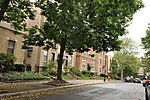University of Connecticut School of Law
1921 establishments in ConnecticutBuildings and structures in Hartford, ConnecticutEducation in Hartford, ConnecticutEducational institutions established in 1921Law schools in Connecticut ... and 3 more
National Register of Historic Places in Hartford, ConnecticutUniversities and colleges in Hartford County, ConnecticutUniversity of Connecticut

The University of Connecticut School of Law (UConn Law) is the law school associated with the University of Connecticut and located in Hartford, Connecticut. It is the only public law school in Connecticut and one of only four in New England. In 2020 it enrolled 488 JD students.
Excerpt from the Wikipedia article University of Connecticut School of Law (License: CC BY-SA 3.0, Authors, Images).University of Connecticut School of Law
Elizabeth Street, Hartford
Geographical coordinates (GPS) Address Phone number Website External links Nearby Places Show on map
Geographical coordinates (GPS)
| Latitude | Longitude |
|---|---|
| N 41.7731 ° | E -72.7076 ° |
Address
University of Connecticut School of Law (UConn Law)
Elizabeth Street 55
06105 Hartford
Connecticut, United States
Open on Google Maps








